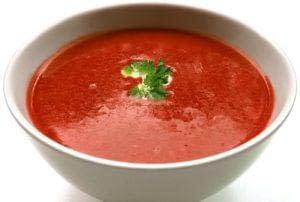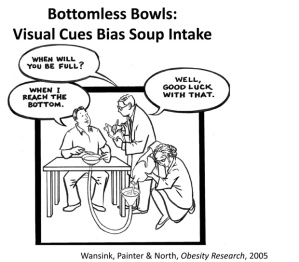When it comes to food and fullness, perception is everything, and environmental cues matter.
 In a 2005 study conducted by Cornell University professors, 54 participants attended a lunch. Half of the participants ate tomato soup from normal bowls, while the other half unowingly ate from magical self-refilling bowls. No matter how much soup they ate, the bowl would imperceptibly refill itself. Sneaky devils
In a 2005 study conducted by Cornell University professors, 54 participants attended a lunch. Half of the participants ate tomato soup from normal bowls, while the other half unowingly ate from magical self-refilling bowls. No matter how much soup they ate, the bowl would imperceptibly refill itself. Sneaky devils
The findings?
On average, the participants eating fom the bottomless soup bowls ate 73% more soup (113 calories worth), than the non-refilling counterparts, regardless of sex or BMI. The bottomless soup bowl participants also thought they had consumed the same amount as their fellow “normal” soup bowl participants. Even more interesting? Those who ate from the bottomless soup bowls did not feel any difference in satiation than those eating from the normal bowls.
Just like the previously discussed milkshake study, it would seem that how much we think we’ve eaten, may influence our appetite and hunger more than how much we’ve actually eaten, with environmental clues being particularly important. In the study, the participants who ate from the bottomless bowls were using visual cues (how high the soup filled the bowl) to decide when to stop eating. But since the fill lines never lowered… they never stopped! It is our eyes, rather than our stomachs, which often tell us if we’re “full” or not.
THE TAKEAWAY?
Now, my purpose with this post, is not to say we should monitor calories or consciously restrict food via portion sizes. No no no! Rather, I just want to highlight the connection between our brain and food, as well as the need for mindful eating. For the former, it is clear that our brain’s perception may, at times, have more to do with how food makes us feel, than our actual stomachs. So when you consider that modern foods are often engineered to be addictive, making our brains want more, it’s no wonder typical weight loss is difficult!
Beyond that, I believe it is also important to cultivate a mindful approach towards eating. One of the awesome things about intermittent fasting, is it allows you to effectively feast like there’s no tomorrow, if structured correctly. Paleo also lets you indulge in vast amounts of food. That being said, while food becomes awesomely indulgent in a whole foods lifestyle, mindfulness is still important! I just finished reading Mindful Eating by Jan Chozen Bays, which explores various mindfulness techniques when it comes to meals.
I see the mindful tension in me personally when I’m eating out, versus eating at home. When I’m at a nice dinner with family or friends, I tend to savor my meal, paying more attention to each bite. A single “normal” meal can fill me up for the evening, despite the fact I likely haven’t eaten all day. Compare this to my routine at home eating, where I’m typically distracted with writing/researching/etc. During this time, I can EASILY eat 2 lbs of steak, 10 cucumbers, and 2 pints of strawberries in one sitting. (I’ve recently jumped on a slightly higher carb wagon – to be discussed in future posts!) The same goes with wine. When out with friends and personally paying for expensive wine by the glass, I’m more “in tune.” I drink the wine more slowly, savoring every drop (with a sip of water in between to discourage wine stains!) A single glass leaves me satisfied. Compare this to when I’m drinking cheap wine with dinner at home – the sky’s the limit!
I guess we all have our own “Bottomless Bowls” in life.

